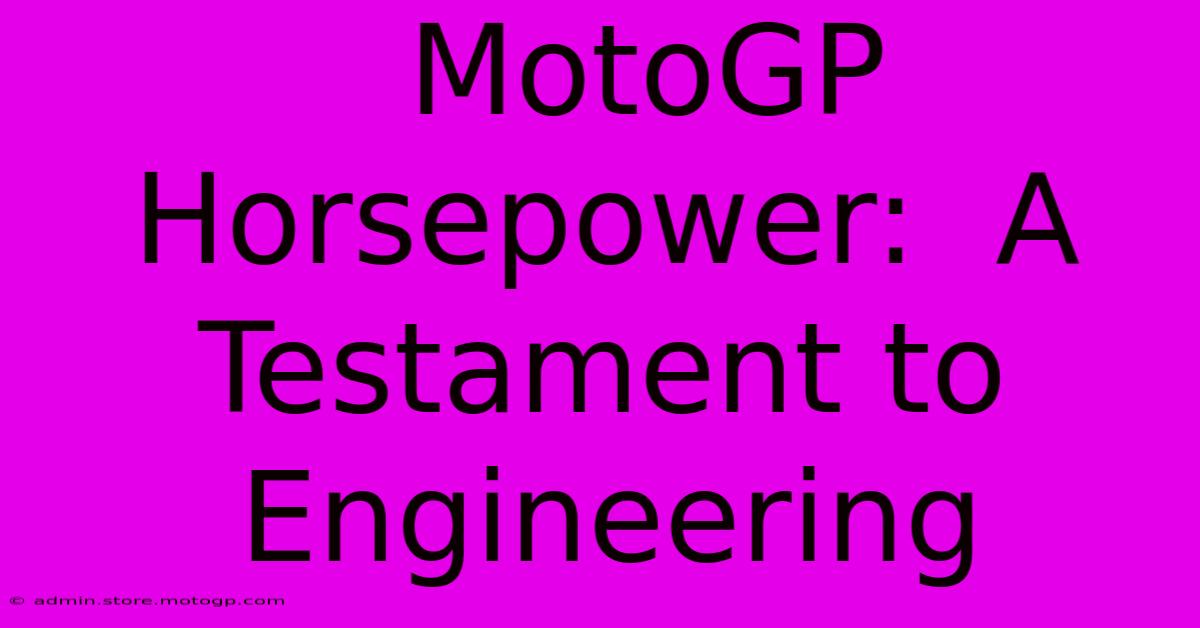MotoGP Horsepower: A Testament To Engineering

Table of Contents
MotoGP Horsepower: A Testament to Engineering
MotoGP. The name itself conjures images of screaming engines, breathtaking speeds, and the ultimate test of rider skill. But behind the spectacle lies a marvel of engineering, a relentless pursuit of horsepower that pushes the boundaries of what's possible. This article delves into the incredible horsepower figures achieved in MotoGP, exploring the technology and innovation that make these machines so powerful.
Unleashing the Beasts: Horsepower in MotoGP
The horsepower figures in MotoGP are staggering. While exact numbers are closely guarded secrets by manufacturers, estimates consistently place the current crop of MotoGP bikes well above 260 horsepower. This power is squeezed from engines typically displacing just 1000cc, showcasing the incredible efficiency and technological advancements in MotoGP engine design. This contrasts sharply with road bikes, where similar engine capacities might produce significantly less horsepower. The difference? Advanced technology and a relentless focus on performance.
The Secrets to the Power: Technology and Innovation
Several key factors contribute to the monumental horsepower figures in MotoGP:
-
Pneumatic Valves: MotoGP engines often utilize pneumatic valve actuation systems. These systems use compressed air to control valve timing and lift, allowing for incredibly precise control and enabling higher RPMs and improved breathing. This results in a significant horsepower boost.
-
Sophisticated Engine Management Systems: The brains behind the beast are highly advanced engine control units (ECUs). These systems constantly monitor and adjust various engine parameters – fuel injection, ignition timing, and valve actuation – optimizing performance for every moment on the track.
-
Lightweight Materials: Every gram counts in MotoGP. Extensive use of lightweight materials like carbon fiber, titanium, and magnesium keeps the overall weight down, maximizing the power-to-weight ratio. This allows for even greater acceleration and speed.
-
Aerodynamics: While not directly contributing to horsepower, aerodynamics play a crucial role in overall performance. Advanced aerodynamic designs, including winglets and fairings, reduce drag and increase downforce, enhancing cornering speed and stability – which translates to better lap times and higher effective power.
-
High-Revving Engines: MotoGP engines are designed to rev incredibly high, typically exceeding 16,000 RPM. This high RPM range allows for more complete combustion and greater power output.
Beyond the Numbers: The Human Element
While the horsepower figures are impressive, it's crucial to remember the human element. These incredibly powerful machines are ridden by some of the most skilled and daring racers in the world. Their ability to control and manage these beasts at the limits of physics is just as remarkable as the engineering itself. The combination of human skill and engineering prowess is what makes MotoGP so captivating.
The Future of MotoGP Horsepower
The quest for more horsepower in MotoGP is ongoing. Manufacturers are constantly pushing the boundaries of technology, seeking even greater efficiency and power. Expect to see further advancements in areas like materials science, engine management, and aerodynamics in the years to come. The future of MotoGP is likely to feature even more powerful and sophisticated machines, further cementing its status as a pinnacle of motorcycle racing and engineering.
Conclusion: A Symphony of Power and Precision
MotoGP horsepower isn't just about raw power; it's a testament to the dedication, innovation, and precision engineering that goes into creating these incredible machines. The pursuit of higher horsepower is a continuous race, driving advancements that benefit not only MotoGP but also the broader motorcycle industry. The roar of a MotoGP engine is not just a sound; it's a testament to human ingenuity and the relentless pursuit of performance.

Thank you for visiting our website wich cover about MotoGP Horsepower: A Testament To Engineering. We hope the information provided has been useful to you. Feel free to contact us if you have any questions or need further assistance. See you next time and dont miss to bookmark.
Featured Posts
-
Cota Parking Map The Best Way To Park At Cota
Feb 18, 2025
-
Moto Gp Arcade Get Your Adrenaline Pumping
Feb 18, 2025
-
F1 Ratings The Influence Of Team Performance
Feb 18, 2025
-
Motorcycle Race Bikes For Sale Built To Conquer
Feb 18, 2025
-
Yamaha Moto Gp The Underdog Story Latest Team News
Feb 18, 2025
